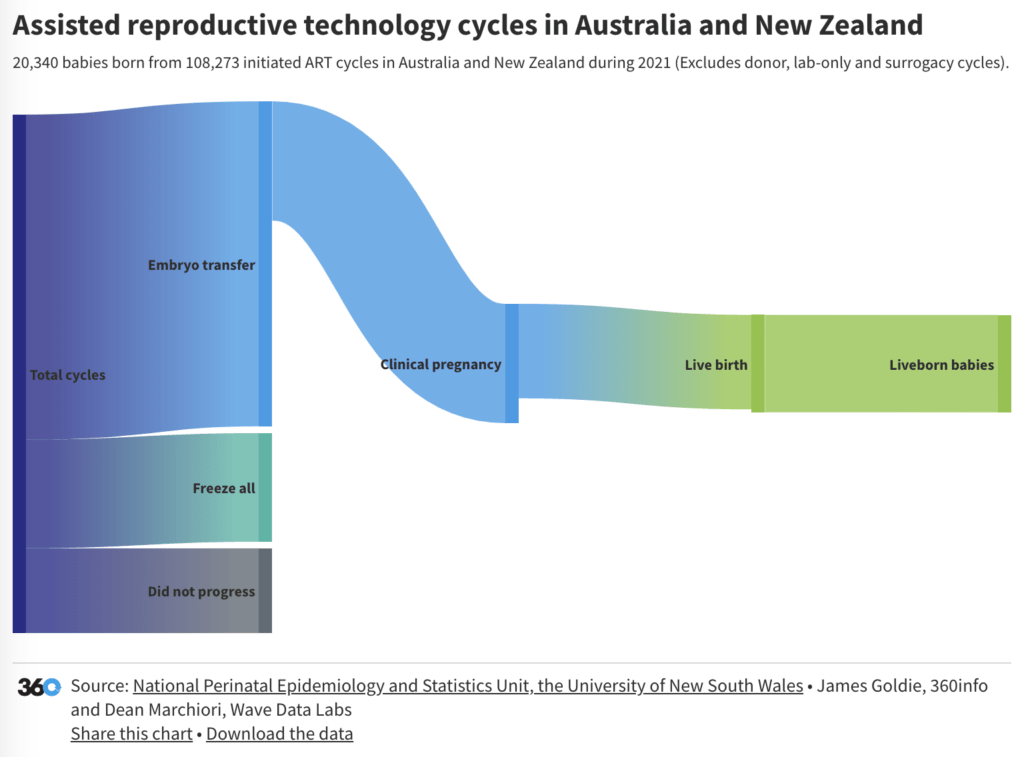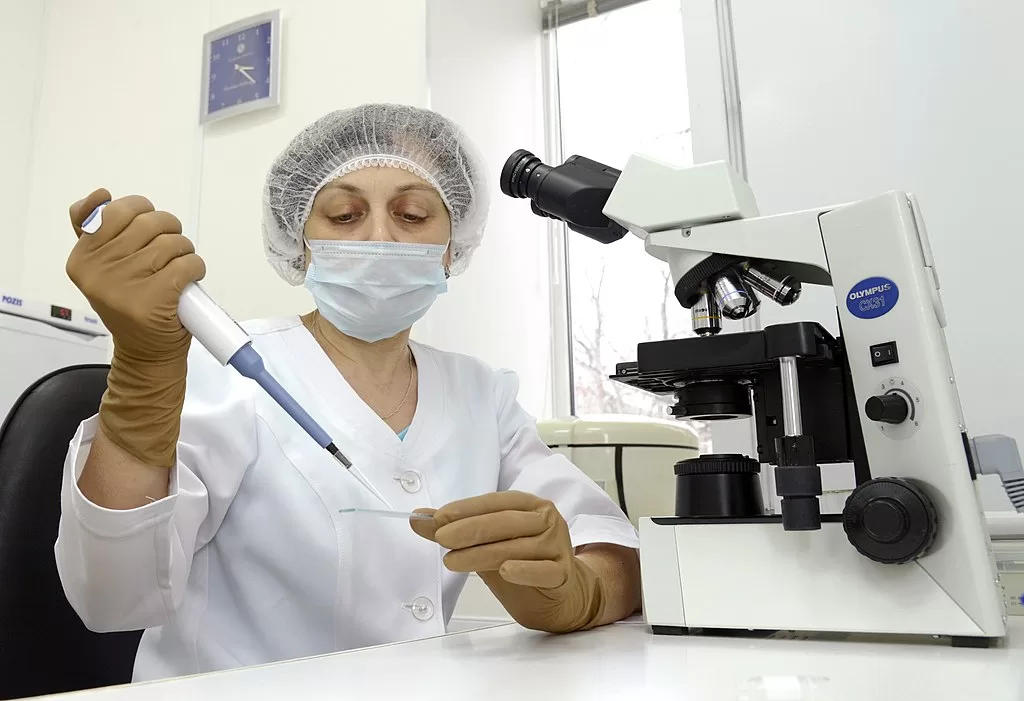The fertility industry is worth billions worldwide, but as demand grows and concerns rise over the cost of care, are patients getting what they need?
 The fertility industry is booming and is expected to grow at over 15 percent each year, to reach USD$84 billion by 2028. : Michael Fallon via Unsplash (https://unsplash.com/photos/grayscale-photo-of-person-holding-baby-2Lg36hSFaWw) Unsplash Licence
The fertility industry is booming and is expected to grow at over 15 percent each year, to reach USD$84 billion by 2028. : Michael Fallon via Unsplash (https://unsplash.com/photos/grayscale-photo-of-person-holding-baby-2Lg36hSFaWw) Unsplash Licence
The fertility industry is worth billions worldwide, but as demand grows and concerns rise over the cost of care, are patients getting what they need?
The Australian family is getting smaller every year, with the birth rate now at 1.63 children born per woman.
At the same time the Australian market for assisted reproduction technology (ART) treatments is booming, expected to hit revenues of AUD$700 million in 2023.
Most Australian ART is provided by private clinics, some of which are operated by large Australian or overseas-owned corporations. This helps to make services more accessible, but there are concerns that the cost to patients and government for these treatments is rising.
The Australian government currently subsidises an unlimited number of IVF cycles for people diagnosed with infertility, but the out-of-pocket costs for one IVF cycle even for those eligible for the Medicare subsidy is usually between AUD$5,000 to AUD$6,000.
As part of a 2022 survey for women in the ACT, health professionals were able to hear first hand the struggles women were having in gaining ART treatments.
“We could get a rebate but honestly it was just too expensive to contemplate IVF for us. If we hadn’t found the Sydney clinic that bulk bills, we wouldn’t have been able to do IVF,” one participant told the survey.
“We have had to delay treatment each time we have done a cycle, in order to be able to afford it,” another said.
Australian ART professionals and consumers interviewed for a recent National Health and Medical Research Council (NHMRC)-funded study on the influence of commercialisation on ART were concerned about the expense of co-payments, and the cost and value of services provided.
There were reports of patients drawing down on their mortgages and superannuation and borrowing from relatives in order to fund treatment. The participants in the research also reported that patients are sometimes insufficiently informed about the financial costs of treatment.
Regional and rural patients stand to pay even more — for travel, accommodation, and lost work, for example — and to experience discontinuities in their care.
“It must have been my first—it must have been my second scan I was having, and I thought I was meeting the new consultant. I’m not a fan of ultrasounds, as many people are not, and I was quite anxious about having this second one. Got there and it was a different consultant and he was absolutely terrible … he just knew nothing about me, hadn’t read anything … and that really put me off the system because I thought I was seeing a particular doctor – and then he was there”, said one woman interviewed for the research.
The combination of out-of-pocket costs and poor service access in rural and regional areas is leading to growing concern about equity of access to ART in Australia.
Meeting the needs of the millennial generation, who have fewer assets and often carry education debts at the time they seek to start families, can be expected to accentuate the problems experienced by patients and funders.
This is not just an Australian issue. Globally, the fertility industry has become a multi-billion-dollar market. In 2022, the global market reached USD$35.2 billion, and it is expected to grow at over 15 percent each year, to reach USD$84 billion in 2028.
An April 2023 WHO report showed that 1 in 6 people worldwide experience infertility issues.
Falling birth rates and rising longevity put pressure on public finance and compel governments to generate policies to reverse demographic decline.
This has been accompanied by an explosion in demand for fertility services in both developed and emerging economies and a correspondingly rapid growth in IVF and other ART-related techniques and services.
It is expected that demand for ART will continue to increase along with the factors (such as education levels and financial precarity) that influence the deferral of child-bearing.
The growth of the private ART sector has undoubtedly stimulated innovation and provided choice for many people who have had life-changing positive outcomes. But there are downsides.
Patients may also receive treatments that are not right for them or for which evidence of benefit is lacking. Some of these treatments may even be harmful. There is also concern about the sector’s advertising and marketing practices, including its promotion of ‘egg-freezing’ services.
Growing commercialisation has been associated with the standardisation of care. While standardisation can be beneficial, it can be harmful if patients feel like they are ‘just a number’ or if it means that their individual clinical, psychological and financial circumstances are not taken into account.
The use of ‘add-ons’ – interventions that are ‘added to’ conventional IVF treatment cycles with the aim of improving outcomes or the patient experience – is another subject of intense debate in the sector.
Many add-ons are expensive. A small number are of benefit in defined circumstances, but most are of equivocal, little, or no value. They are, nonetheless, in wide use.
There is already a great deal of concern in the community about the cost of ART, industry practices – such as advertising and marketing – and aspects of the patient experience, such as lack of personalised care and poor informed consent procedures. Several jurisdictions in Australia have conducted reviews and made recommendations for improving the system.
If the distribution of services continues to be left to the market, regional and rural patients might continue to have less, and less reliable, access to services.
In the absence of a coordinated workforce plan, service demand may outstrip supply, and the inequity of access we see already may get worse. In such circumstances, costs might be expected to rise.
Without greater coordination of research and innovation across the sector, success rates may not improve as much as they otherwise could, and the proliferation of costly non-evidence based interventions is likely to continue.
Without comprehensive policy and regulatory control, the safety, fairness and sustainability of services for ‘egg-freezing’ and surrogacy and sperm donation may not be guaranteed.
It is likely that private sector involvement in ART will remain essential if the community’s growing need for access to fertility treatments is to be met.
Depending, however, on societal values and preferences as to how public resources are spent, governments may need to explore how they use financial levers in order to get the right balance of access, quality and cost.
A more balanced system with increased participation by the public sector, may also be needed if we are to address equity concerns (particularly for regional residents and lower income families) and restore the sector’s commitment to responsible innovation and evidence based practice.
While there may be room to improve the ethical awareness and commitment of individual professionals and organisations, a more accountable – perhaps independent – regulatory system would help to ensure both quality of care and financial fair dealing. Increasing the role of consumer protection regulations and standards in the sector may help to protect patients’ health and financial interests.
Siun Gallagher is postdoctoral researcher working in bioethics at The University of Sydney and Macquarie University. Her research interests focus on the impact of rising clinical and health system complexity on medical practice.
Wendy Lipworth is Professor of Bioethics at Macquarie University. Her research focuses on the ethics and politics of research and innovation.
The research was funded by a grant from the National Health and Medical Research Council (grant number APP 1181401).
Originally published under Creative Commons by 360info™.













